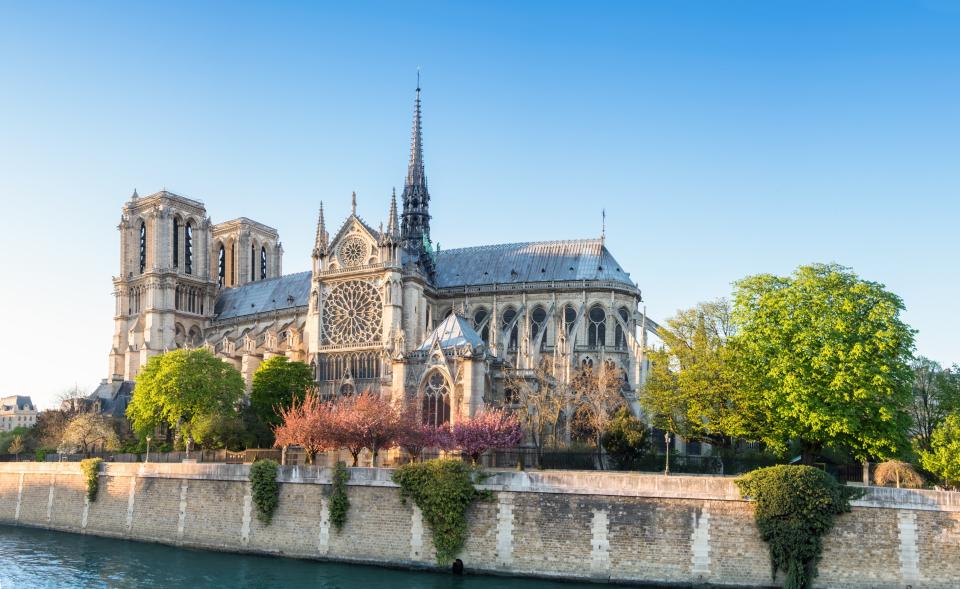The Notre-Dame Redesign Debate Is Over—and It Will Look Exactly the Same
Barely days after it was nearly destroyed by fire in 2019, former French prime minister Édouard Philippe announced that Paris would be holding an international design competition to rebuild—and reimagine—Notre-Dame cathedral’s iconic spire. The spire collapsed (along with much of the building’s roof) in a blaze that prosecutors believed was caused by either an electrical fault or a cigarette.
In his announcement time, Philippe said the French government would seek out “a new spire that is adapted to the techniques and the challenges of our era.” Added French president Emmanuel Macron, in a supporting statement at the time, “a contemporary architectural gesture” would make Notre-Dame “even more beautiful.”
However, over the past week, Macron backtracked on his support of a modernist Notre-Dame redesign. “The president of the republic has become convinced of the need to restore Notre-Dame de Paris in the most consistent manner possible to its last complete, coherent, and known state," the Elysée Palace said in a statement. In other words, the “redesign” will look exactly the same as the original Gothic design, which is what many senior figures in French government were publicly pushing for. Macron added that he will look to the country’s National Heritage and Architecture Commission for guidance on Notre-Dame’s next steps.
The idea that the original spire, conceived by French architect Viollet-le-Duc in the 19th century, would be replaced with a modern reimagining was met with raised eyebrows from architects, academics, and Parisians, 55% of whom, according to a poll, favored the original. The French Senate even passed a bill last year requiring that the restoration of Notre-Dame would be faithful to its “last known visual state.”

Notre Dame Cathedral in Paris on a bright afternoon in Spring
The spire, which was 300 feet tall and made of wood and lead, was added to the cathedral in its 19th-century renovation. The proposed redesigns submitted to the French government, meanwhile, chose modern materials and sustainable design approaches that looked very little like the original. For instance, in the month following the fire, architect Vincent Callebaut’s firm unveiled an eco-friendly, glass blueprint, complete with solar power and an urban farm for vulnerable and homeless Parisians. Paris-based Studio NAB proposed a giant greenhouse, filled with beehives and planters made from the burnt remains of the roof. The government, however, chose to go another way.
Meanwhile, an unofficial competition to redesign Notre-Dame was hosted by GoArchitect, an independent publisher. It saw 226 redesign entries from 56 countries—with the winner chosen after votes were cast by over 30,000 members of the public. Chinese architects Zeyu Cai and Sibei Li won with “Paris Heartbeat,” a design that reinterpreted the spire as a kaleidoscope made of a many-mirrored roof that would reflect “the changing urban environment” outside the cathedral. The duo’s design also included a time capsule, whose magnetic levitation system moved it “rhythmically up and down, breathing and beating together with the city.” (A book featuring the top 50 designs, Visions of Notre-Dame, is available for purchase.)
It’s unclear what will happen to the alternative designs conceived by Callebaut, NAB, and the other studios in light of Macron’s about-face. Matthias Altwicker, the principal architect at studio A+H and an associate professor of architecture at the New York Institute of Technology, sees the decision to keep the original design as a way to avoid what has been an extremely fractious public debate, although he considers the decision a missed opportunity given “Paris’s leadership, historically, in progressive architectural thinking with projects such as the Centre Pompidou.” Altwicker notes that there is precedent for giving historical sites contemporary redesigns (he cites the Kolumba and Wallraf-Richartz museums in Cologne, Germany) as well as monuments that have absorbed different architectural styles over time, noting St. Peter’s Basilica in Rome as an example.
And, as Callebeaut’s firm pointed out in a description about its design, in spite of historic preservation rules, Notre-Dame, too, has a history of adapting to the times: “From primitive Gothic in the 12th century to its restoration by Viollet-le Duc in the 19th century, through the radiant Gothic of the 13th century, and the flamboyant Gothic of the 14th century, Notre-Dame cathedral undoubtedly arises from centuries of work and multifaceted inspiration,” Callebeut said in a statement.
Originally Appeared on Architectural Digest


